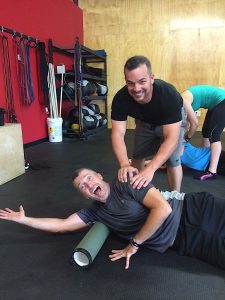Coaches Corner – March 2017
In this month’s Coaches Corner, coach Lewter shares an article that emphasizes the importance of maintaining a strong core and ways to improve your core.
https://breakingmuscle.com/learn/at-the-core-of-it-creating-strength-and-tension-in-the-body
Coaches Corner-January 2016-Focus on Mobility
In this month’s Coaches Corner, we bring to you an article featuring the mobility guru, Kelly Starrett. While it is important to do mobility after your workout, it is equally as important to do additional mobility every day. Check out these 6 exercises you can do at home to get or stay supple!
https://www.outsideonline.com/2139871/six-daily-exercises-boost-mobility-and-balance
Tips for Success with Nutrition and Fitness-Related New Year’s Resolutions
By Lisa Grellinger
It’s that time of year again, “New Year, New me!” While some of us roll our eyes at this, for others this really is a clean slate and a new launching pad to start working towards achieving goals. Many of us set goals in the realm of nutrition and fitness, ie: “lose 10lbs,” “gain more muscle,” “add 20lbs to my back squat,” etc. These are all great goals that we are here to help you achieve! Here are a few quick tips on setting yourself up for success with regards to these goals:
- Make “SMART” goals. This is an acronym that serves as a guide for setting goals. They should be S-Specific (ie: “train 3 days a week” vs “go to the gym”) M- Measureable (ie:“lose 5% body fat” vs “lose weight”) A- Attainable (ie: “add 5lbs to my snatch PR” vs “add 500lbs to my snatch PR”) R- Realistic (ie: “eat a cleaner and healthier diet” vs “never eating another carb ever again!”) T- Timely (ie: “by July 1st/within 3months/ etc.” vs “eventually”).
- Be Accountable. Share your goals with your fellow athletes, a coach, family, and/or friends. Having others to motivate you and hold you accountable along the way make you much more likely to reach your goals! You can also hold yourself accountable in ways like keeping a food log and training log.
- Be Mindful. Remind yourself of the reasons you want to achieve your goals. Do you want to improve your overall health? Maybe you want to compete? Or maybe you want to be on less medication. Keeping these motivators in mind help you to be mindful with your decisions. For example, “Am I really hungry, or am I just bored? If I eat all this candy will that help me achieve my goal, or set me back” “I really don’t feel like working out today, I’d rather go home and nap, but I also want to get off my blood pressure medicine…. I’ll go to the gym!”
Some of this might sound simple or cheesy, but it really works. You can accomplish anything you set your mind to! We believe in you! If you have any questions, or need some help and encouragement, please see a coach- we are here to help!
BITE-SIZED NUTRITION-DECEMBER 2016
In this month’s Nutrition Notes, we have a great article on how carbohydrates play a key role in overall performance.
Carbohydrate Selections: The Right Carb for the Right Job
Whole, unprocessed carbohydrate sources have significant health and performance benefits that might go unnoticed with macronutrient counting. For example, a doughnut and an orange can both provide the carbohydrate grams one needs, but other constituents should be considered. Even honey has more health value compared to table sugar due to the vitamins and minerals it contains.
This brief describes some of the factors to consider when selecting carbohydrates, including total carbohydrate grams. While the brief is not meant to be exhaustive, this information can help someone make more optimal choices based on needs and goals.
When selecting a carbohydrate, consider these components:
-Total carbohydrate (for body composition)
-Non-caloric constituents (for health)http://journal.crossfit.com/2016/10/carbohydrate-selections-the-right-carb-for-the-right-job.tpl
-Fiber (for satiety)
-Glucose vs. fructose (for recovery)
For the complete article, click here
(Written by E.C. Synkowski)
COACHES CORNER – DECEMBER 2016
This month’s Coaches Corner, is from Coach Craig Marker
Defeat Poor CrossFit Movement With These Work-Rest Strategies
Bite-Sized Nutrition – October 2016
Sugar – Why It’s Been in the News and Why You Should Care
Americans have a problem with sugar. Our consumption of the sweet stuff goes up every year as does the weight of the average American. Each American averages about 160 lbs of sugar consumption each year!
But in a few ways it’s not our fault. Genetically we are wired to like it. Scientists theorize animals (including us humans) evolved to like riper fruit because it had a higher sugar content than unripe fruit and therefore supplied more energy. So our taste for sweet has been with us for a long time. Researchers have also studied the power of that sweet taste in mice to show that it is more addicting than cocaine!
“Our findings clearly demonstrate that intense sweetness can surpass cocaine reward, even in drug-sensitized and -addicted individuals. We speculate that the addictive potential of intense sweetness results from an inborn hypersensitivity to sweet tastants. In most mammals, including rats and humans, sweet receptors evolved in ancestral environments poor in sugars and are thus not adapted to high concentrations of sweet tastants. The supranormal stimulation of these receptors by sugar-rich diets, such as those now widely available in modern societies, would generate a supranormal reward signal in the brain, with the potential to override self-control mechanisms and thus to lead to addiction.”
But given that we are genetically predisposed to like the stuff, a perhaps bigger problem that fed into America’s obesity epidemic began some time ago when Harvard scientists were paid to downplay sugar’s possible role in America’s heart disease and place the blame on fat. This is the story that hit mainstream media recently and has stirred up a lot of controversy.
As part of that effort, John Hickson, a sugar-industry executive, funded research by Harvard scientists that was intended, explicitly, to exculpate sugar as a major risk factor for coronary heart disease and to cast blame instead on saturated fat. That research resulted in a 1967 article in the New England Journal of Medicine making that exact case. One of the scientists Hickson funded eventually became head of nutrition at the U.S. Department of Agriculture, where he helped author a draft of what would become the government’s first official nutritional guidelines—guidelines that recommended a low-fat diet.
The nutritional guidelines drafted at that time are still around today and still used by many medical professionals to recommend a low-fat, high carbohydrate diet. These recommendations have also spurred the products that you see on your grocery store shelves; the ones in which naturally occurring fats are removed from products and replaced by un-naturally occurring high fructose corn syrup and other sugars.
The reason that this is all is a big deal, and why sugar has been big in the news lately is best summed up with this quote from The New Yorker: A Big Tobacco Moment for the Sugar Industry
The sugar industry was “trying to enlist the government to carry out its work, by reshaping Americans’ diets. The result was the proliferation of low-fat, high-carb diets, which many researchers argue has helped fuel the recent obesity boom. Big Sugar’s campaign may have started in the sixties, but we’re still paying for it today.”
Americans have been confused about health for decades. It does not have to continue! We’ll end this article with a quote from CrossFit Founder, Coach Greg Glassman. This is a quote that every athlete should revisit often as it may be the most succinct quote regarding the prescription to attaining lifelong fitness:
World-Class Fitness in 100 Words:
“Eat meat and vegetables, nuts and seeds, some fruit, little starch and no sugar. Keep intake to levels that will support exercise, but not body fat. Practice and train major lifts: Deadlift, clean, squat, presses, C&J, and snatch. Similarly, master the basics of gymnastics: pull-ups, dips, rope climb, push-ups, sit-ups, and presses to handstand, pirouettes, flips, splits, and holds. Bike, run, swim, row, etc., hard and fast. Five or six days per week mix these elements in as many combinations and patterns as creativity will allow. Routine is the enemy. Keep workouts short and intense. Regularly learn and play new sports.”
– Coach Greg Glassman, CrossFitFounder and CEO (Courtesy of CrossFit Inc.)
.
Coaches Corner – October 2016
Are You Getting Enough (Sleep)?
This month, CFJC coach, Dan Sturm writes:
As part of the Challenge we are running right now at CFJC, we’ve been talking lately about all of the parts of your life – other than diet and exercise – that can affect your health and wellness. Things like: Hydration, Mobility, Stress management, and sleep.
One of our members at CFJC, Dr. Raju, knows a couple things about how sleep – or rather the lack of it – can affect your brain and in turn affect your weight. The other night he rattled off a bunch of cool doctor things about how your brain and your hormones are affected by the lack of sleep. We found this article that summed up what he said that we think you will enjoy: How Sleep Deprivation Fries Your Hormones Your Immune System and Your Brain.
Bite-Sized Nutrition – September 2016
Suck Less Through Proper Hydration
Hydration is important. We all know that right? We’ve heard it a million times. But what does that mean?
CrossFit workouts are designed to be high-intensity. But did you know that the capacity to perform high-intensity exercise, is reduced by as much as 45% by prior dehydration corresponding to a loss of only 2.5% of body weight!*
Got your attention yet? Bottom line: If you go into a workout slightly dehydrated, you are going to suck.
Here’s how to suck less by making sure you are properly hydrated.
Coaches Corner – September 2016
Mobility and Goals for Long-Term Fitness
Mobility is a common word used in the CrossFit community, usually to describe a set of stretching or “muscle-smashing” exercises. Others might use the term to define limitations in the body’s ability to attain the correct position when performing a specific movement. For instance, an overhead squat cannot be properly executed without appropriate “mobility” in the hips, shoulders, and ankles.
So what is mobility in terms of long-term fitness?
Mobility
mōˈbilədē/
noun
The ability to move or be moved freely and easily.

Mobility has to do with more than just flexibility. When it comes to consistent training and long-term fitness, it is “the measure of how well, easily, and unassisted a person can move.” So, next time you think of mobility, also consider these things: how pain-free is the movement? How much time in your day is spent in motion?
When your coaches incorporate mobility training in your CrossFit classes, they are aiding your body in recovery. The goal with post-workout mobility is really about the next day of training. Unnecessary soreness in muscles will limit your range of motion and certainly affect your willingness to move well and easily in your next workout. Further, coaches have an interest in increasing your level of flexibility. Increased flexibility allows the athlete to move correctly, which decreases risk of injury.
So what does all this mean to you?
 1. Prioritize Movement at Work
1. Prioritize Movement at Work
- Sit less. When taking phone calls or taking a break, choose to stand or go for a walk
- Take regular, intentional breaks. Do a lap of the office or go for a short walk every hour
- If possible, go and talk to colleagues in person rather than sending an email or calling on the phone
- If you have a standing desk, change positions often. Studies show that both sitting and standing for a prolonged period of time is detrimental to your health
- When sitting, make sure you have good posture.
- After a long drive, take time to stretch, walk and loosen up your body. If driving to meet with a client, try to go for a walk when you first greet each other or schedule a tour of the facility before you get down to business. You benefit from walking after a long drive, and you might be surprised what a great ice breaker this can be
2. Consider the Importance of Warming-up
Next time you are at the gym and it is time to start your class, don’t dread the group warm-up! It should not be rushed, and you certainly should never skip it. This time is intended to get your muscles, joints, and, more importantly, your lungs and heart primed for the work that your body is about to do. Most of us arrive at the gym after long periods of time with restricted movement. Ease your body into the workout that is to come.
3. Form Trumps Time or Weight
During training, focus on your technique, train your body to move correctly, and avoid the habit of disregarding form for the sake of getting through the movements quickly. Avoid disregarding form for the sake of an extra second off your “Fran” time. In competition, there are times where that extra second or extra pound may mean a world of difference; while training, good form should be the goal. In the long run, good form reduces the risk of injury, while increasing efficiency in the movement.
4. Mobilize After Your Workout
After a tough workout, you’re lying on the floor, focused on the pain in your muscles. The idea of spending even 5-10 minutes on mobilization is more than you can bear- right? I challenge you to change your mindset. Teach yourself that your training is not over once you finish the WOD. The workout is only complete when you have treated your body to a mobility session that will make it possible for you come back the next day. The time immediately after your workout, when your body is nice and warm, is a great opportunity to work on flexibility or even accessory work.
To close, regular mobilization is treating your body with kindness. Mobility will allow the athlete to maintain their performance status for the long-term, while increasing mobility and minimizing recovery time. You only have one body, so take good care of it: warm-up, prioritize movement in everyday life, and find the value in post-workout mobility. Every athlete should enjoy the blessing of being able to move well, easily, and unassisted for years to come.



